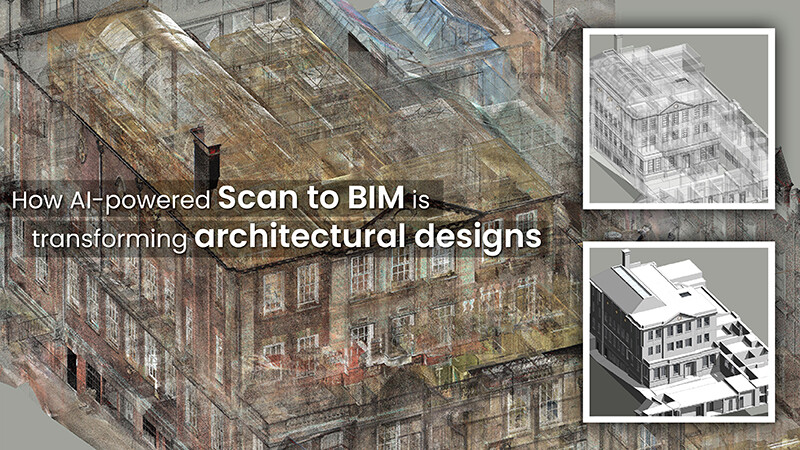AI-powered design tools provide 25-30% efficiency improvements within architectural design workflows, streamlining generative design, improving sustainability, and supporting predictive analytics. According to a study, 68% architectural firms explored or implemented AI-driven tools by 2024.
Without the use of AI, Architectural Scan-to-BIM can be time-consuming, laborious, error-prone, and inconsistent.
Modeling intricate details and geometries from point cloud data can create roadblocks leading to BIM model inaccuracies. Moreover, larger architectural design projects can become difficult to manage due to lack of scalability. AI helps to streamline and manage the data and design workflow, reducing such issues.
For example, while Revit and Navisworks lack the presence of pre-built AI tools, integrations and third-party plugins can help bridge technology requirements.
Aurivus and PointCAD uses AI algorithms to convert point cloud data into 3D BIM model elements and can be integrated with Revit. Similarly, OpenSpace and Cintoo Cloud can support Navisworks in using AI for clash detection and site walkthroughs. Tools like 3D Repo, Verity and CupixWorks provide capabilities such as model federation, automated clash detection, and data validation.
In this article, we discuss the presence of AI-driven technology within the Scan-to-BIM workflow for architecture to automate tasks, enhance accuracy and facilitate data-driven insights for an AI-driven assessment.
How AI supports Scan-to-BIM services in architectural design
Artificial Intelligence (AI) has boosted Scan-to-BIM services significantly through improvements in accuracy, efficiency and automation.
AI-based algorithms assess complex and vast point cloud data from laser scans to identify and classify objects, such as windows, walls and other structural members. This removes the requirement for manual modeling, which can be time-consuming.
Additionally, AI-driven tools help architecture and design teams automatically flag clashes and ambiguities within the Point Cloud to BIM models and scanned realities. This ensures a greater level of accuracy and reduces error risks during on-site construction.
Overall, automation of repetitive tasks and delivery of valuable insights based on data analysis with AI makes Scan-to-BIM workflows seamless, leading to time, cost and resource savings.
How does AI work in Point Cloud Scan-to-BIM services?
AI-powered Point Cloud Scan-to-BIM services utilize machine learning (ML) to efficiently transform raw point cloud data into intelligent 3D BIM models through a structured process.
First, data capture is performed using laser scanners, which record millions of data points to create a dense and detailed point cloud of the physical space. Next, AI analysis and object identification come into play, where advanced algorithms analyze the data to identify patterns and recognize building objects such as doors, windows, walls, and structural components. The AI segments the point cloud by grouping data points based on distinct features. Finally, in the automated 3D model generation stage, AI-based software generates precise 3D models that replicate real-world objects while defining their geometrical relationships.
Modern AI tools can handle even complex geometries, such as irregular shapes and curved surfaces, with high efficiency. This automation not only accelerates the Scan-to-BIM model creation process but also ensures superior accuracy and detailed representation, significantly reducing manual effort and time.
Architectural Scan-to-BIM workflow powered by AI/ML
The architectural Scan-to-BIM workflow is revolutionized by Artificial Intelligence (AI) and Machine Learning (ML), enhancing each stage of the process.
It begins with data acquisition and point cloud processing, where AI-powered drones optimize flight paths to ensure comprehensive site coverage and efficient data collection. Once the data is captured, AI algorithms refine the raw point cloud by cleaning and filtering it to remove noise, ensuring accurate point registration. Deep learning models then perform semantic segmentation, classifying and labeling distinct architectural components to enable precise identification.
In the next stage, 3D modeling and BIM enhancement, generative AI tools use the segmented and classified data to construct detailed 3D BIM models. These tools establish geometric relationships between components, ensuring accurate spatial representation. Additionally, AI algorithms enrich the BIM model with critical metadata, including information about materials, textures, and structural properties, further enhancing its utility.
Finally, in the analysis and optimization stage, ML algorithms analyze the BIM model to detect and resolve potential clashes between building systems, providing solutions to mitigate design issues. AI also optimizes processes by suggesting energy-efficient and material-saving strategies while automating tasks and generating prototypes.
This advanced workflow enables immersive visualization and seamless collaboration among project stakeholders, promoting informed decision-making throughout the design and construction process.
What are the benefits of Scan-to-BIM powered by AI/ML?
AI significantly enhances and accelerates the process of converting point cloud data into 3D Scan-to-BIM models by automating time-consuming tasks. This automation improves speed and efficiency, leading to reduced labor costs and shorter project timelines as the process becomes more streamlined.
AI's ability to precisely analyze vast datasets ensures the creation of highly accurate as-built models, maintaining fidelity to real-world environments. Furthermore, the enhanced accuracy, combined with automated clash detection, allows for proactive problem-solving by identifying potential issues early in the project lifecycle.
AI-driven Scan-to-BIM also transforms project communication and collaboration. The AI-generated 3D models serve as a centralized platform for easy information access, ensuring all stakeholders remain aligned. Improved project visualization provides a clearer understanding of the design, fostering better collaboration among teams.
These benefits collectively lead to improved project outcomes, including higher accuracy, early clash detection, and smoother workflows. Ultimately, these advancements contribute to reduced errors, minimized rework, and the mitigation of project delays, enhancing overall project efficiency and delivery.
Wrapping it up
The combination of Scan-to-BIM, AI, and the expertise of BIM services providers will continue to transform the architectural landscape.
The improvements in accuracy, gains in efficiency, and data-driven insights delivered by AI tools are not mere increments but significant advancements in how buildings are designed, built, and maintained. By leveraging the capabilities of BIM services providers, these technologies streamline workflows and enhance collaboration. As AI and ML continue to evolve, the architecture industry anticipates even greater sophistication in processes, including automated workflows and generative design.






